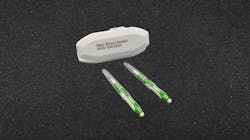Chairside Impact: Tipped interdental brush from Summit Oral Care
Interdental cleaning is extremely important and can lead patients to better oral and systemic health. More than 47% of adults over the age of 30 have some form of periodontal disease; this increases to 70.1% among patients 65 and older. We now know that people with gum disease have two to three times the risk of having a heart attack, stroke, or other serious cardiovascular event. The research also shows that up to 50% of heart attacks may be triggered by an oral infection.1
Oral bacteria has been found in stroke victims’ brains, in Alzheimer’s patients’ brains, and in synovial joints.2–4 Periodontitis raises blood sugar and may lead to type 2 diabetes.5 Oral disease impacts the rest of the body. Inflammation in one area can communicate to the other parts of the body.6 Dental plaque is an etiological factor in the development of chronic periodontal disease, which can eventually lead to tooth loss, if untreated.7
More Chairside Impact:
- Pulpdent Embrace Varnish and Sealant
- Monarch Lines Cleaner and CleanStream Evacuation System Cleaner
- Orascoptic RDH EliteEdge Loupes and Endeavor Headlight
The Centers for Disease Control and Prevention (CDC) recommends brushing and flossing every day to remove the bacteria that cause gum disease. A toothbrush is inadequate when it comes to removing interproximal plaque. Studies show that only 30% of Americans floss daily, 37% floss inconsistently, and over 32% of the population never floss.8 If our patients aren’t flossing, isn’t it our obligation to find them something easy, effective, and portable that they’re more likely to use?
Summit Oral Care has developed a unique tipped interdental brush that provides a soft, comfortable way to eliminate the gum sensitivity that comes with inflamed gum tissue and gum recession. The latex-free elastomer coverage of the wired tip protects against galvanic shock and prevents trauma to the gum tissue. The tipped interdental brush has a bendable neck to help clean hard-to-reach areas. The carrying case comes with two brushes with individual caps that protect the bristles when not in use and can be used as a handle extension.
Once I started offering patients interdental brushes, their compliance was amazing. Their gums looked healthier, and they felt great about improving their oral health. I found the best compliance results came from getting a brush in the patient’s hand in the office and showing them how to use it. Giving them a sample to use and take home shows them what to buy when it’s time to replace it.
Interdental brushes remove the plaque from concavities that floss misses. For this reason, I have patients who floss use interdental brushes, too. In one study, interdental brushes removed more plaque than dental floss or wood sticks. There was also a more pronounced reduction in pocket depth when compared to floss.9 In another study, the effectiveness of interproximal brushes had the greatest reduction of inflammation on buccal surfaces when compared to floss, flossers, and soft picks.10
Since we now know that the mouth is the gateway to the rest of the body, dental professionals are patients’ first line of defense. Let’s give them everything they need to practice optimal oral health. Let’s be lifesavers!
Editor's note: This article appeared in the June 2022 print edition of RDH magazine. Dental hygienists in North America are eligible for a complimentary print subscription. Sign up here.References
- Gum disease and heart disease: The common thread. Harvard Health Publishing. February 15, 2021. https://www.health.harvard.edu/heart-health/ gum-disease-and-heart-disease-the-common-thread
- Mouth bacteria found in stroke patients’ brains. What does it mean? American Heart Association News. May 23, 2019. https:// www.heart.org/en/news/2019/05/23/mouth-bacteria-found-instroke- patients-brains-what-does-it-mean
- Dominy SS, Lynch C, Ermini F, et al. Porphyromonas gingivalis in Alzheimer’s disease brains: Evidence for disease causation and treatment with small-molecule inhibitors. Sci Adv. 2019;5(1):eaau3333. doi:10.1126/sciadv.aau3333
- Chukkapalli S, Rivera-Kweh M, Gehlot P, et al. Periodontal bacterial colonization in synovial tissues exacerbates collagen-induced arthritis in B10.RIII mice. Arthritis Res Ther. 2016;18(1):161. doi:10.1186/s13075-016-1056-4
- Gum disease can raise your blood sugar level. American Dental Association. 2013. https://www.mouthhealthy.org/~/media/ADA/ Publications/Files/FTDP_July2013_2.pdf?la=en
- Konkel JE, O’Boyle C, Krishnan S. Distal consequences of oral inflammation. Front Immunol. 2019;10:1403. doi:10.3389/ fimmu.2019.01403
- Sambunjak D, Nickerson JW, Poklepovic T, et al. Flossing for the management of periodontal diseases and dental caries in adults. Cochrane Database Syst Rev. 2011;(12):CD008829. doi:10.1002/14651858.CD008829.pub2
- Sternberg S. How many Americans floss their teeth? US News. May 2, 2016. http://www.usnews.com/news/ articles/2016-05-02/how-many-americans-floss-their-teeth
- Slot DE, Dörfer CE, Van der Weijden GA. The efficacy of interdental brushes on plaque and parameters of periodontal inflammation: a systematic review. Int J Dent Hyg. 2008;6(4):253-264. doi:10.1111/j.1601-5037.2008.00330.x
- Yost KG, Mallatt ME, Liebman J. Interproximal gingivitis and plaque reduction by four interdental products. J Clin Dent. 2006;17(3):79-83.
About the Author
Jodie Heimbach, BS, RDH
Jodie Heimbach, BS, RDH, is a clinical calibration coach with Productive Dentist Academy. Jodie’s passion is empowering teams to work smarter, not harder, while taking the best care of their patients. Jodie is a graduate of Fones School of Dental Hygiene and O’Hehir University. She is a 2008 Sunstar/RDH Award of Distinction recipient and past president of the New Jersey Dental Hygienists’ Association.
Updated May 10, 2022
